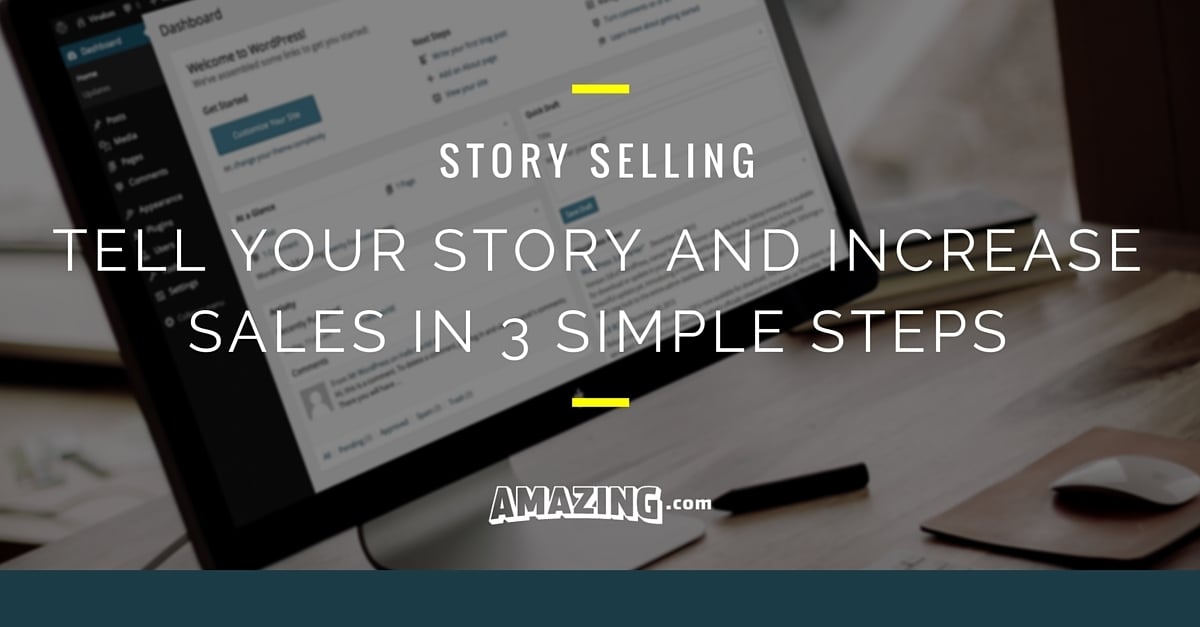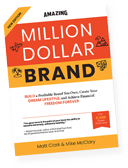Story Selling: Tell Your Story and Increase Sales in 3 Simple Steps

So there I was, drinking my failure away? The bar smelled like a mix between mold and brass doorknobs, and it seemed like the perfect scene to endlessly contemplate the mistake I had just made.
I had just sent an email out to 230,000 people with THE WRONG BLEEPING LINK. No, the world didn’t come to the end, but nothing makes you feel like more of a failure than something simple going wrong where everything complex, your real expertise, in the process had gone so perfectly. One mistake, a stupid one at that, completely undid all the faith my client had in me. If it were socially acceptable I would have probably let a few tears land on the brass bar top.
There was no one there really, one guy who clearly had been there too long. And a woman who’s padded shoulder jacket made it pretty clear she hadn’t been out in a while. A pretty sad scene indeed, sad enough to inspire the bartender to turn to me and, almost like he was setting up a bad joke, say, “Why the long face my man?”
“You ever make a mistake you could have prevented with two more minutes of work that wipes out two months worth of credibility?” I said almost compulsively. I really just wanted SOMEONE to understand, though I figure I’d skip the technical parts.
“Well sure, but why did you make the mistake?” … WHY? I hadn’t considered there was a why… Why? Because I’m an idiot! Because I didn’t think. Because I evidently didn’t care enough about the project.
Wait?
None of that was true, I did care about the project, and I get paid big bucks because of what I know. So why DID I make that mistake? I’m a smart guy… I shouldn’t make simple mistakes like that.
“Well?” he said, realizing I was stuck in my inner dialogue… Snapping back I said, “I don’t really know… It was preventable, I just didn’t remember to check something, and it cost us big time.”
“Bet you won’t forget next time will you?” he said as he returned to wiping down the bar.
Wow, I thought, he’s right… It was an expensive mistake, but I definitely wouldn’t make that mistake again. And you know what?
It gave me an idea… What if there was a little bit of software that forced you to double check links in your email? It cost me a lot to miss that simple mistake, and surely others had made the same mistake. I know something like this software could help tons of people!
The above is an example of a marketing origin story. As you read it did you feel a bit of empathy for our downtrodden hero? Did you get a little excited when he had his epiphany? Well believe it or not YOUR product, service, or business has a story just like this (and many more) just waiting to be released! And man are they POWERFUL.
In fact I’m willing to put my reputation on the line and say they are the most important part of any marketing plan. In this blog post I’m going to show you the exact three steps to take to develop, write, and create your marketing story in a FUN way. I?m also going to show you how to implement it into your current marketing strategy to increase sales.
Throughout my journeys in the marketing community, generally at events or masterminds, usually someone will pop the question, “What would you do if you had to start and grow a business from scratch?” After a Manhattan or two I explain the very first thing you need to do when starting, or restarting, a business is…
Know Your Hero Story
I suppose there are lots of places to start with a business venture. Generally we start with an idea and we say, “Wow, good job me. That’s a great idea!” However, if you want it to not just be a hobby you’ll need to really clarify and define your story. In fact I’ve seen it time and time again: A product or service or company with a good story is what separates seven-figure products from six, and eight-figure brands from seven-figure ones.
I don’t mean like a Pixar film where you define your hero and his/her struggle? Well…wait…actually I do! Pixar is a perfect example of a company that knows the importance of story. Their own story is very interesting, their struggle to get started, to break the form of the traditional Disney cartoon story type, the WAY they develop their stories…It’s almost too perfect of a metaphor for how YOU can actually define your own story.
Why is you or your product’s story important? It’s the authentic foundation of a brand that goes beyond the factual reasons someone should buy to the emotional, and much more powerful, reasons they should buy.
Basically, before you start building a website, start writing marketing material, or even start making the product, you need to define its story. The story will help you establish the real value of your product for your customer.
Think about it, the last 20 purchases you made, how many of them were based on emotion? Be honest, listen to your inner dialogue when you shop. It’s a very interesting world up there in our buying brains.
The Exercise
DEFINE YOUR STORY, IMPLEMENT IN YOUR BUSINESS
First thing I want you to do is forget about your product or service or business (let’s refer to this as PSB. from now on). Let’s talk about you for a minute. Behind every PSB is a person, and the story as to why they?re building their PSB. If you’re that person, your story to WHY you started your PSB is important. You might not think it is, but it will help you write your marketing pieces.
When you’re writing your marketing materials it’s usually a one-way conversation. You’re trying to convince your audience that YOUR way is the best way. Your unique selling point is supposed to do the work. And you know what, you still need that, but in this age of ?everything’s been done? you?re not going to be that unique for long before someone comes along who’s faster, smarter, or more motivated. This is another reason story is so important.
Customers will buy when they feel understood. And they will buy from you instead of your competition every time if they feel your values match theirs.
The oldest tool in human history for helping someone understand that they’re understood? STORY.
Here’s the simple exercise to help you define your story!
Step 1: Get out of marketing mode. If you’re used to writing marketing copy like “WARNING: THIS ONE TRICK WILL MAKE YOUR FEET NOT SMELL, YOU WON’T BELIEVE NUMBER 7 LOL,? leave that at the door. You need to get into “talking to a friend” mode. Best way to do that? Get a friend involved. The next part involves telling your story, so you might as well tell it to someone!
Step 2: Grab a friend (not literally) and grab a drink (if that?s your thing) at a bar or at home ? it’s heart-to-heart conversation time. You need to answer the following question, and make sure to record the conversation:
“I know your PSB does XYZ, but WHY did you start it in the first place?” Ask your friend to keep asking you follow-up questions that start with WHY.
10 Suggested Questions to Build the Foundation of Your Story
- How does your product or service help people who use it?
- Why is that important?
- From your experience using the product or your customers using the product, what problems have they avoided?
- Why is that important?
- How did you come up with the idea for the product?
- What experiences did you (or your customer) have before using the product?
- Why shouldn?t people wait to start using your product?
- What is one thing that people THINK they know about your product, but they?re usually wrong about?
- If you had to beg someone to use your product to help them avoid something, how would you beg them?
- Who is your product not for?
When you start feeling emotional about the discussion, or when responses really start to get heated about how much you dislike how people currently do things wrong related to your PSB, then you know you’ve reached your story.
Step 3: Did you record the conversation? Good! Usually at this point with clients I’ll get the conversation transcribed. In this transcription is almost everything you need to shape ALL your marketing. Your WHY answers contain the nuggets that create your brand, business, product, service, and your story. Generally you’ll find the problem (the antagonist in your story) defined as time-wasting, energy-draining, money-losing, soul-crushing ways of doing things without your PSB. Thus your PSB becomes the Hero ? solving that problem once and for all and with everyone living happily ever after!
This exercise defines:
- the origin story, the epiphany that led to the birth of an idea
- the Eternal Struggle aka the problem we all face
- the Valiant Hero aka you or your PSB
- the Wise Sage, aka what inspired you
- the ‘Excalibur’ aka the Solution, and why it’s better than others
What can you do now that you have your story?
- Create your sales page.
- Create your video sales letter (VSL).
- Develop your advertising campaigns.
- Create your follow-up emails.
- Define the mission of your blog.
- And really anything else that requires the framework.
Basically all your online marketing should live around your story, and once you have it you can do amazing things with your marketing!
So what?s your story? The world is waiting for you to tell it! Learn how to publish it on your own website with the ?Amazing.com Special Report: From Zero to Selling Online with WordPress. ?Click here to take advantage of this incredible offer ? it’s 100% FREE!![]()
Find your first--or next--product to sell fast
Discover top-selling products on Amazon. See accurate sales trends and profit estimates so your next product succeeds. Plus, plan out your entire product and brand with a new custom AI tool unavailable anywhere else.
Heading 1
with a request body that specifies how to map the columns of your import file to the associated CRM properties in HubSpot.... In the request JSON, define the import file details, including mapping the spreadsheet's columns to HubSpot data. Your request JSON should include the following fields:... entry for each column.


